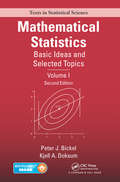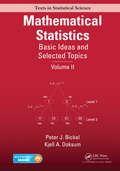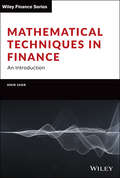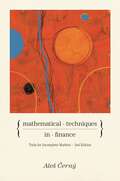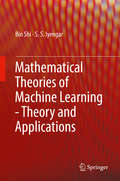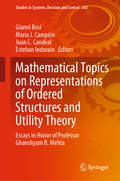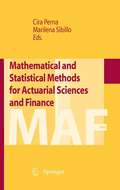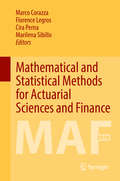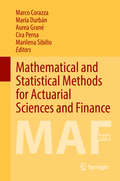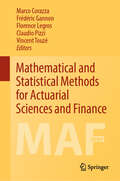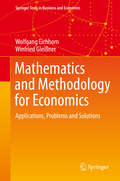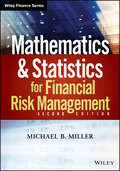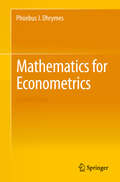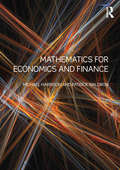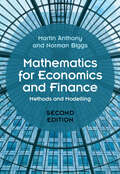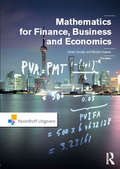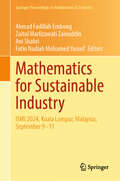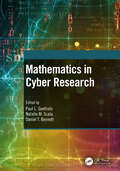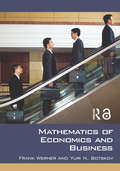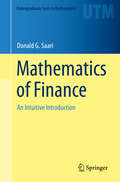- Table View
- List View
Mathematical Statistics: Basic Ideas and Selected Topics, Volume I, Second Edition (Chapman & Hall/CRC Texts in Statistical Science)
by Peter J. Bickel Kjell A. DoksumMathematical Statistics: Basic Ideas and Selected Topics, Volume I, Second Edition presents fundamental, classical statistical concepts at the doctorate level. It covers estimation, prediction, testing, confidence sets, Bayesian analysis, and the general approach of decision theory. This edition gives careful proofs of major results and explains ho
Mathematical Statistics: Basic Ideas and Selected Topics, Volume II (Chapman And Hall/crc Texts In Statistical Science Ser. #119)
by Peter J. Bickel Kjell A. DoksumMathematical Statistics: Basic Ideas and Selected Topics, Volume II presents important statistical concepts, methods, and tools not covered in the authors' previous volume. This second volume focuses on inference in non- and semiparametric models. It not only reexamines the procedures introduced in the first volume from a more sophisticated point o
Mathematical Techniques in Finance: An Introduction (Wiley Finance)
by Amir SadrExplore the foundations of modern finance with this intuitive mathematical guide In Mathematical Techniques in Finance: An Introduction, distinguished finance professional Amir Sadr delivers an essential and practical guide to the mathematical foundations of various areas of finance, including corporate finance, investments, risk management, and more. Readers will discover a wealth of accessible information that reveals the underpinnings of business and finance. You’ll learn about: Investment theory, including utility theory, mean-variance theory and asset allocation, and the Capital Asset Pricing Model Derivatives, including forwards, options, the random walk, and Brownian Motion Interest rate curves, including yield curves, interest rate swap curves, and interest rate derivativesComplete with math reviews, useful Excel functions, and a glossary of financial terms, Mathematical Techniques in Finance: An Introduction is required reading for students and professionals in finance.
Mathematical Techniques in Finance: Tools for Incomplete Markets - Second Edition
by Ales CernýOriginally published in 2003, Mathematical Techniques in Finance has become a standard textbook for master's-level finance courses containing a significant quantitative element while also being suitable for finance PhD students. This fully revised second edition continues to offer a carefully crafted blend of numerical applications and theoretical grounding in economics, finance, and mathematics, and provides plenty of opportunities for students to practice applied mathematics and cutting-edge finance. Ales Cerný mixes tools from calculus, linear algebra, probability theory, numerical mathematics, and programming to analyze in an accessible way some of the most intriguing problems in financial economics. The textbook is the perfect hands-on introduction to asset pricing, optimal portfolio selection, risk measurement, and investment evaluation. The new edition includes the most recent research in the area of incomplete markets and unhedgeable risks, adds a chapter on finite difference methods, and thoroughly updates all bibliographic references. Eighty figures, over seventy examples, twenty-five simple ready-to-run computer programs, and several spreadsheets enhance the learning experience. All computer codes have been rewritten using MATLAB and online supplementary materials have been completely updated. A standard textbook for graduate finance courses Introduction to asset pricing, portfolio selection, risk measurement, and investment evaluation Detailed examples and MATLAB codes integrated throughout the text Exercises and summaries of main points conclude each chapter
Mathematical Theories of Machine Learning - Theory and Applications
by Bin Shi S. S. IyengarThis book studies mathematical theories of machine learning. The first part of the book explores the optimality and adaptivity of choosing step sizes of gradient descent for escaping strict saddle points in non-convex optimization problems. In the second part, the authors propose algorithms to find local minima in nonconvex optimization and to obtain global minima in some degree from the Newton Second Law without friction. In the third part, the authors study the problem of subspace clustering with noisy and missing data, which is a problem well-motivated by practical applications data subject to stochastic Gaussian noise and/or incomplete data with uniformly missing entries. In the last part, the authors introduce an novel VAR model with Elastic-Net regularization and its equivalent Bayesian model allowing for both a stable sparsity and a group selection.
Mathematical Topics on Representations of Ordered Structures and Utility Theory: Essays in Honor of Professor Ghanshyam B. Mehta (Studies in Systems, Decision and Control #263)
by Gianni Bosi María J. Campión Juan C. Candeal Esteban IndurainThis book offers an essential review of central theories, current research and applications in the field of numerical representations of ordered structures. It is intended as a tribute to Professor Ghanshyam B. Mehta, one of the leading specialists on the numerical representability of ordered structures, and covers related applications to utility theory, mathematical economics, social choice theory and decision-making. Taken together, the carefully selected contributions provide readers with an authoritative review of this research field, as well as the knowledge they need to apply the theories and methods in their own work.
Mathematical and Statistical Methods for Actuarial Sciences and Finance
by Cira Perna Marilena SibilloThis volume aims to collect new ideas presented in the form of 4 page papers dedicated to mathematical and statistical methods in actuarial sciences and finance. The cooperation between mathematicians and statisticians working in insurance and finance is a very fruitful field and provides interesting scientific products in theoretical models and practical applications, as well as in scientific discussion of problems of national and international interest. This work reflects the results discussed at the biennial conference on Mathematical and Statistical Methods for Actuarial Sciences and Finance (MAF), born at the University of Salerno in 2004.
Mathematical and Statistical Methods for Actuarial Sciences and Finance
by Cira Perna Marilena Sibillo Marco Corazza Florence LegrosThe interaction between mathematicians and statisticians has been shown to be an effective approach for dealing with actuarial, insurance and financial problems, both from an academic perspective and from an operative one. The collection of original papers presented in this volume pursues precisely this purpose. It covers a wide variety of subjects in actuarial, insurance and finance fields, all treated in the light of the successful cooperation between the above two quantitative approaches. The papers published in this volume present theoretical and methodological contributions and their applications to real contexts. With respect to the theoretical and methodological contributions, some of the considered areas of investigation are: actuarial models; alternative testing approaches; behavioral finance; clustering techniques; coherent and non-coherent risk measures; credit scoring approaches; data envelopment analysis; dynamic stochastic programming; financial contagion models; financial ratios; intelligent financial trading systems; mixture normality approaches; Monte Carlo-based methods; multicriteria methods; nonlinear parameter estimation techniques; nonlinear threshold models; particle swarm optimization; performance measures; portfolio optimization; pricing methods for structured and non-structured derivatives; risk management; skewed distribution analysis; solvency analysis; stochastic actuarial valuation methods; variable selection models; time series analysis tools. As regards the applications, they are related to real problems associated, among the others, to: banks; collateralized fund obligations; credit portfolios; defined benefit pension plans; double-indexed pension annuities; efficient-market hypothesis; exchange markets; financial time series; firms; hedge funds; non-life insurance companies; returns distributions; socially responsible mutual funds; unit-linked contracts. This book is aimed at academics, Ph. D. students, practitioners, professionals and researchers. But it will also be of interest to readers with some quantitative background knowledge.
Mathematical and Statistical Methods for Actuarial Sciences and Finance
by Claudio Pizzi Marco CorazzaThe interaction between mathematicians and statisticians has been shown to be an effective approach for dealing with actuarial, insurance and financial problems, both from an academic perspective and from an operative one. The collection of original papers presented in this volume pursues precisely this purpose. It covers a wide variety of subjects in actuarial, insurance and finance fields, all treated in the light of the successful cooperation between the above two quantitative approaches. The papers published in this volume present theoretical and methodological contributions and their applications to real contexts. With respect to the theoretical and methodological contributions, some of the considered areas of investigation are: actuarial models; alternative testing approaches; behavioral finance; clustering techniques; coherent and non-coherent risk measures; credit scoring approaches; data envelopment analysis; dynamic stochastic programming; financial contagion models; financial ratios; intelligent financial trading systems; mixture normality approaches; Monte Carlo-based methods; multicriteria methods; nonlinear parameter estimation techniques; nonlinear threshold models; particle swarm optimization; performance measures; portfolio optimization; pricing methods for structured and non-structured derivatives; risk management; skewed distribution analysis; solvency analysis; stochastic actuarial valuation methods; variable selection models; time series analysis tools. As regards the applications, they are related to real problems associated, among the others, to: banks; collateralized fund obligations; credit portfolios; defined benefit pension plans; double-indexed pension annuities; efficient-market hypothesis; exchange markets; financial time series; firms; hedge funds; non-life insurance companies; returns distributions; socially responsible mutual funds; unit-linked contracts. This book is aimed at academics, Ph. D. students, practitioners, professionals and researchers. But it will also be of interest to readers with some quantitative background knowledge.
Mathematical and Statistical Methods for Actuarial Sciences and Finance: MAF 2018
by Cira Perna Marilena Sibillo Marco Corazza María Durbán Aurea GranéThe interaction between mathematicians, statisticians and econometricians working in actuarial sciences and finance is producing numerous meaningful scientific results. This volume introduces new ideas, in the form of four-page papers, presented at the international conference Mathematical and Statistical Methods for Actuarial Sciences and Finance (MAF), held at Universidad Carlos III de Madrid (Spain), 4th-6th April 2018. The book covers a wide variety of subjects in actuarial science and financial fields, all discussed in the context of the cooperation between the three quantitative approaches. The topics include: actuarial models; analysis of high frequency financial data; behavioural finance; carbon and green finance; credit risk methods and models; dynamic optimization in finance; financial econometrics; forecasting of dynamical actuarial and financial phenomena; fund performance evaluation; insurance portfolio risk analysis; interest rate models; longevity risk; machine learning and soft-computing in finance; management in insurance business; models and methods for financial time series analysis, models for financial derivatives; multivariate techniques for financial markets analysis; optimization in insurance; pricing; probability in actuarial sciences, insurance and finance; real world finance; risk management; solvency analysis; sovereign risk; static and dynamic portfolio selection and management; trading systems. This book is a valuable resource for academics, PhD students, practitioners, professionals and researchers, and is also of interest to other readers with quantitative background knowledge.
Mathematical and Statistical Methods for Actuarial Sciences and Finance: MAF2024
by Claudio Pizzi Marco Corazza Florence Legros Frédéric Gannon Vincent TouzéThe book presents a collection of peer-reviewed short papers selected from those presented at the International Conference Mathematical and Statistical Methods for Actuarial Sciences and Finance – MAF2024. The year 2024 marks the twentieth anniversary of the first edition of this conference. The idea behind this book is that collaboration and cross-pollination between mathematicians and statisticians working in actuarial sciences and finance could enhance research in these fields. The effectiveness of this concept has been demonstrated by widespread participation across all editions, held at various locations including the University of Salerno, Italy (2004, 2006, 2010, 2014, and 2022); Ca' Foscari University of Venice, Italy (2008, 2012, and 2020); University Paris-Dauphine in Paris, France (2016); University Carlos III of Madrid, Madrid (2018); and University of Le Havre Normandie, Le Havre, France (2024). This effectiveness is also evident in the attention consistently shown by both the scientific community and professionals toward the volumes of peer-reviewed papers accompanying all past editions of MAF. The book is a valuable resource for academics, researchers, Ph.D. students, and professionals. Furthermore, it is also of interest to other readers with a quantitative background.
Mathematics For Retail Buying, 9th Edition
by Marla Greene Bette K. TepperMathematics for Retail Buying, Ninth Edition, introduces merchandising and retailing students to the most important concepts in retail math through step-by-step examples with practice problems and solutions. Coverage begins with the skeletal profit and loss statement and moves through retail pricing and repricing of merchandise, markups, markdowns, the retail method of inventory, six-month, and assortment planning. This new edition introduces a practical approach that incorporates actual retail scenarios and concepts that are relevant to the fashion industry today. There is also a focus on mathematical factors that affect the gross margin and profitability, key to the success of any merchandise buyer or planner. New to this Edition · Updated mathematical practice problems with selected answers in the back of the book for review · Updated case studies reflect realistic and practical merchandising situations · Thoroughly updated and revised text to reflect most common practices in the field of Mathematics for Retail Buying STUDIO -Study smarter with self-quizzes featuring scored results and personalized study tips -Review concepts with flashcards of terms and definitions and key formulas -Practice your skills by computing Practice Problems from the text, available digitally with formulas embedded in the Excel spreadsheets -Enhance your knowledge with additional real-world case studies and activities for each chapter
Mathematics and Methodology for Economics
by Wolfgang Eichhorn Winfried GleißnerThis book about mathematics and methodology for economics is the result of the lifelong experience of the authors. It is written for university students as well as for students of applied sciences. This self-contained book does not assume any previous knowledge of high school mathematics and helps understanding the basics of economic theory-building. Starting from set theory it thoroughly discusses linear and non-linear functions, differential equations, difference equations, and all necessary theoretical constructs for building sound economic models. The authors also present a solid introduction to linear optimisation and game theory using production systems. A detailed discussion on market equilibrium, in particular on Nash Equilibrium, and on non-linear optimisation is also provided. Throughout the book the student is well supplied with numerous examples, some 2000 problems and their solutions to apply the knowledge to economic theories and models.
Mathematics and Statistics for Financial Risk Management (Wiley Finance)
by Michael B. MillerMathematics and Statistics for Financial Risk Management is a practical guide to modern financial risk management for both practitioners and academics. Now in its second edition with more topics, more sample problems and more real world examples, this popular guide to financial risk management introduces readers to practical quantitative techniques for analyzing and managing financial risk. In a concise and easy-to-read style, each chapter introduces a different topic in mathematics or statistics. As different techniques are introduced, sample problems and application sections demonstrate how these techniques can be applied to actual risk management problems. Exercises at the end of each chapter and the accompanying solutions at the end of the book allow readers to practice the techniques they are learning and monitor their progress. A companion Web site includes interactive Excel spreadsheet examples and templates. Mathematics and Statistics for Financial Risk Management is an indispensable reference for today’s financial risk professional.
Mathematics for Consumers
by Kathleen M. HarmeyerMathematics for Consumers presents basic math skills used in everyday situations such as Earning Money, Buying Food, Shopping for Clothes, Managing a Household, Buying and Maintaining a Car, Working with Food, Improving Your Home, Traveling, Budgeting Your Money, Banking and Investing, Paying Taxes, Preparing for Careers, etc.
Mathematics for Econometrics
by Phoebus J. DhrymesThis book deals with a number of mathematical topics that are of great importance in the study of classical econometrics. There is a lengthy chapter on matrix algebra, which takes the reader from the most elementary aspects to the partitioned inverses, characteristic roots and vectors, symmetric, and orthogonal and positive (semi) definite matrices. The book also covers pseudo-inverses, solutions to systems of linear equations, solutions of vector difference equations with constant coefficients and random forcing functions, matrix differentiation, and permutation matrices. Its novel features include an introduction to asymptotic expansions, and examples of applications to the general-linear model (regression) and the general linear structural econometric model (simultaneous equations).
Mathematics for Economics and Finance
by Michael Harrison Patrick WaldronThe aim of this book is to bring students of economics and finance who have only an introductory background in mathematics up to a quite advanced level in the subject, thus preparing them for the core mathematical demands of econometrics, economic theory, quantitative finance and mathematical economics, which they are likely to encounter in their final-year courses and beyond. The level of the book will also be useful for those embarking on the first year of their graduate studies in Business, Economics or Finance. The book also serves as an introduction to quantitative economics and finance for mathematics students at undergraduate level and above. In recent years, mathematics graduates have been increasingly expected to have skills in practical subjects such as economics and finance, just as economics graduates have been expected to have an increasingly strong grounding in mathematics. The authors avoid the pitfalls of many texts that become too theoretical. The use of mathematical methods in the real world is never lost sight of and quantitative analysis is brought to bear on a variety of topics including foreign exchange rates and other macro level issues.
Mathematics for Economics and Finance: Methods And Modelling
by Martin Anthony Norman BiggsAccessible, concise, and interactive, this book introduces the mathematical methods that are indispensable in economics and finance. Fully updated to be as student friendly as possible, this edition contains extensive problems, worked examples and exercises (with full solutions at the end of the book). Two brand new chapters cover coupled systems of recurrence/differential equations, and matrix diagonalisation. All topics are motivated by problems from economics and finance, demonstrating to students how they can apply the mathematical techniques covered. For undergraduate students of economics, mathematics, or both, this book will be welcomed for its clarity and breadth and the many opportunities it provides for readers to practise and test their understanding.
Mathematics for Economists with Applications
by James BerginMathematics for Economists with Applications provides detailed coverage of the mathematical techniques essential for undergraduate and introductory graduate work in economics, business and finance. Beginning with linear algebra and matrix theory, the book develops the techniques of univariate and multivariate calculus used in economics, proceeding to discuss the theory of optimization in detail. Integration, differential and difference equations are considered in subsequent chapters. Uniquely, the book also features a discussion of statistics and probability, including a study of the key distributions and their role in hypothesis testing. Throughout the text, large numbers of new and insightful examples and an extensive use of graphs explain and motivate the material. Each chapter develops from an elementary level and builds to more advanced topics, providing logical progression for the student, and enabling instructors to prescribe material to the required level of the course. With coverage substantial in depth as well as breadth, and including a companion website at www.routledge.com/cw/bergin, containing exercises related to the worked examples from each chapter of the book, Mathematics for Economists with Applications contains everything needed to understand and apply the mathematical methods and practices fundamental to the study of economics.
Mathematics for Finance, Business and Economics (Routledge-Noordhoff International Editions)
by Irénée Dondjio Wouter KrasserMastering the basic concepts of mathematics is the key to understanding other subjects such as Economics, Finance, Statistics, and Accounting. Mathematics for Finance, Business and Economics is written informally for easy comprehension. Unlike traditional textbooks it provides a combination of explanations, exploration and real-life applications of major concepts. Mathematics for Finance, Business and Economics discusses elementary mathematical operations, linear and non-linear functions and equations, differentiation and optimization, economic functions, summation, percentages and interest, arithmetic and geometric series, present and future values of annuities, matrices and Markov chains. Aided by the discussion of real-world problems and solutions, students across the business and economics disciplines will find this textbook perfect for gaining an understanding of a core plank of their studies.
Mathematics for Sustainable Industry: ISMI 2024, Kuala Lumpur, Malaysia, September 9–11 (Springer Proceedings in Mathematics & Statistics #496)
by Ahmad Fadillah Embong Zaitul Marlizawati Zainuddin Ani Shabri Fatin Nadiah Mohamed YussofThis volume gathers selected, peer-reviewed contributions presented at the 5th International Seminar on Mathematics in Industry – ISMI2024, held on September 9-11, 2024 in Kuala Lumpur, Malaysia. Articles in this volume touch on fields such as applied mathematics, applied probability theory and stochastic modeling, statistical modeling, operations research, biomathematics, optimization, inventory management, supply chain, and computational mathematics, all with an emphasis on solutions to real-world problems. Many of the studies contained here closely relate to the United Nations&’ Sustainable Development Goals, namely SDG 9 (Industry) and SDG 3 (Health), potentially inspiring practitioners and scholars to deploy these findings and pursue similar avenues of research. Since its inception in 2013, ISMI has been organized by the Centre for Industrial and Applied Mathematics (UTM-CIAM) and the Department of Mathematical Sciences, Universiti Teknologi Malaysia (UTM) with the aims of disseminating knowledge, sharing experiences in research on various aspects of industrial mathematics and statistics and fostering collaboration among academia, government agencies, industry, and community.
Mathematics for economics and finance
by Martin Anthony Norman BiggsMathematics has become indispensable in the modelling of economics, finance, business and management. Without expecting any particular background of the reader, this book covers the following mathematical topics, with frequent reference to applications in economics and finance: functions, graphs and equations, recurrences (difference equations), differentiation, exponentials and logarithms, optimisation, partial differentiation, optimisation in several variables, vectors and matrices, linear equations, Lagrange multipliers, integration, first-order and second-order differential equations. The stress is on the relation of maths to economics, and this is illustrated with copious examples and exercises to foster depth of understanding. Each chapter has three parts: the main text, a section of further worked examples and a summary of the chapter together with a selection of problems for the reader to attempt. For students of economics, mathematics, or both, this book provides an introduction to mathematical methods in economics and finance that will be welcomed for its clarity and breadth.
Mathematics in Cyber Research
by Paul L. GoethalsIn the last decade, both scholars and practitioners have sought novel ways to address the problem of cybersecurity. Innovative outcomes have included applications such as blockchain as well as creative methods for cyber forensics, software development, and intrusion prevention. Accompanying these technological advancements, discussion on cyber matters at national and international levels has focused primarily on the topics of law, policy, and strategy. The objective of these efforts is typically to promote security by establishing agreements among stakeholders on regulatory activities. Varying levels of investment in cyberspace, however, comes with varying levels of risk; in some ways, this can translate directly to the degree of emphasis for pushing substantial change. At the very foundation or root of cyberspace systems and processes are tenets and rules governed by principles in mathematics. Topics such as encrypting or decrypting file transmissions, modeling networks, performing data analysis, quantifying uncertainty, measuring risk, and weighing decisions or adversarial courses of action represent a very small subset of activities highlighted by mathematics. To facilitate education and a greater awareness of the role of mathematics in cyber systems and processes, a description of research in this area is needed. Mathematics in Cyber Research aims to familiarize educators and young researchers with the breadth of mathematics in cyber-related research. Each chapter introduces a mathematical sub-field, describes relevant work in this field associated with the cyber domain, provides methods and tools, as well as details cyber research examples or case studies. Features One of the only books to bring together such a diverse and comprehensive range of topics within mathematics and apply them to cyber research. Suitable for college undergraduate students or educators that are either interested in learning about cyber-related mathematics or intend to perform research within the cyber domain. The book may also appeal to practitioners within the commercial or government industry sectors. Most national and international venues for collaboration and discussion on cyber matters have focused primarily on the topics of law, policy, strategy, and technology. This book is among the first to address the underpinning mathematics.
Mathematics of Economics and Business
by Frank Werner Yuri N. SotskovFor all students who wish to understand current economic and business literature, knowledge of mathematical methods has become a prerequisite. Clear and concise, with precise definitions and theorems, Werner and Sotskov cover all the major topics required to gain a firm grounding in this subject including sequences, series, applications in finance, functions, differentiations, differentials and difference equations, optimizations with and without constraints, integrations and much more. Containing exercises and worked examples, precise definitions and theorems as well as economic applications, this book provides the reader with a comprehensive understanding of the mathematical models and tools used in both economics and business.
Mathematics of Finance: An Intuitive Introduction (Undergraduate Texts in Mathematics)
by Donald G. SaariThis textbook invites the reader to develop a holistic grounding in mathematical finance, where concepts and intuition play as important a role as powerful mathematical tools. Financial interactions are characterized by a vast amount of data and uncertainty; navigating the inherent dangers and hidden opportunities requires a keen understanding of what techniques to apply and when. By exploring the conceptual foundations of options pricing, the author equips readers to choose their tools with a critical eye and adapt to emerging challenges. Introducing the basics of gambles through realistic scenarios, the text goes on to build the core financial techniques of Puts, Calls, hedging, and arbitrage. Chapters on modeling and probability lead into the centerpiece: the Black–Scholes equation. Omitting the mechanics of solving Black–Scholes itself, the presentation instead focuses on an in-depth analysis of its derivation and solutions. Advanced topics that follow include the Greeks, American options, and embellishments. Throughout, the author presents topics in an engaging conversational style. “Intuition breaks” frequently prompt students to set aside mathematical details and think critically about the relevance of tools in context. Mathematics of Finance is ideal for undergraduates from a variety of backgrounds, including mathematics, economics, statistics, data science, and computer science. Students should have experience with the standard calculus sequence, as well as a familiarity with differential equations and probability. No financial expertise is assumed of student or instructor; in fact, the text’s deep connection to mathematical ideas makes it suitable for a math capstone course. A complete set of the author’s lecture videos is available on YouTube, providing a comprehensive supplementary resource for a course or independent study.
